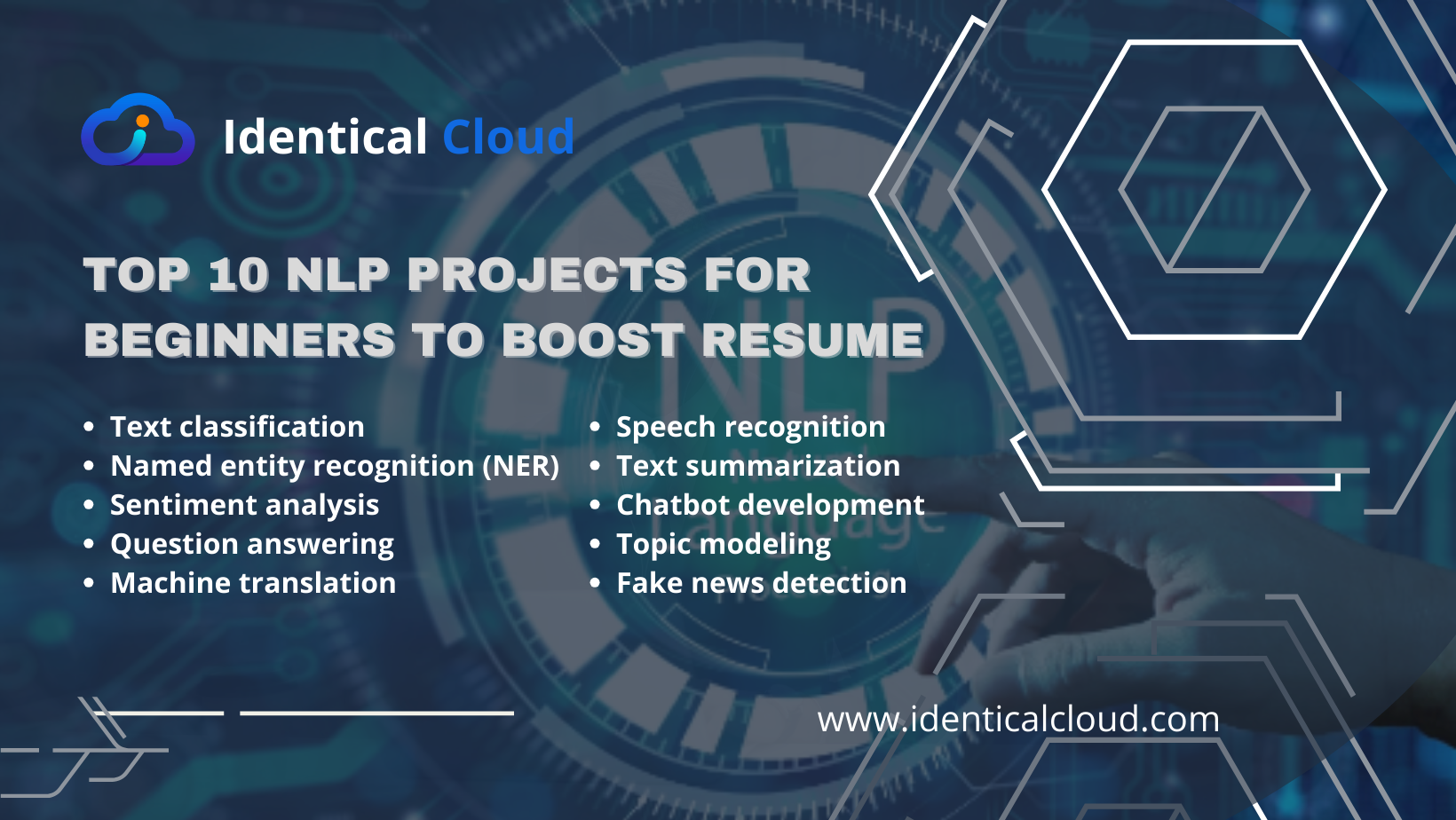
Top 10 NLP Projects For beginners to Boost Resume
Top 10 NLP Projects For beginners to Boost Resume
Natural language processing (NLP) is a field of computer science that deals with the interaction between computers and human (natural) languages. It’s a rapidly growing field with a wide range of applications, including machine translation, speech recognition, text analysis, and question answering.
If you’re a beginner in NLP, there are a few things you can do to boost your resume and make yourself more attractive to potential employers. One way is to complete some NLP projects. This will give you hands-on experience with NLP tools and techniques, and it will also show potential employers that you’re passionate about the field.
Here are 10 NLP projects that are perfect for beginners:
Text classification
Text classification is a classic NLP task that involves classifying text into different categories. For example, you could build a text classifier to classify emails as spam or not spam, or to classify movie reviews as positive or negative.
To build a text classifier, you will need to use a machine learning algorithm. There are many different machine learning algorithms that can be used for text classification, such as Naive Bayes, support vector machines (SVMs), and logistic regression.
Once you have chosen a machine learning algorithm, you will need to train the algorithm on a dataset of labeled text data. This dataset should contain examples of text from each of the categories that you want to classify.
Once the algorithm is trained, you can use it to classify new pieces of text. To do this, you simply need to feed the algorithm the new piece of text and it will output a prediction of the category that the text belongs to.
Named entity recognition (NER)
Named entity recognition (NER) is a task that involves identifying and classifying named entities in text, such as people, places, and organizations. For example, you could build an NER system to identify the names of people and places in news articles.
To build an NER system, you will need to use a machine learning algorithm. There are many different machine learning algorithms that can be used for NER, such as conditional random fields (CRFs) and bidirectional encoder representations from transformers (BERTs).
Once you have chosen a machine learning algorithm, you will need to train the algorithm on a dataset of labeled text data. This dataset should contain examples of text with named entities annotated.
Once the algorithm is trained, you can use it to identify named entities in new pieces of text. To do this, you simply need to feed the algorithm the new piece of text and it will output a list of named entities, along with their classifications.
Sentiment analysis
Sentiment analysis is a task that involves identifying the sentiment of a piece of text, such as whether it is positive, negative, or neutral. For example, you could build a sentiment analysis system to analyze customer reviews or social media posts.
To build a sentiment analysis system, you will need to use a machine learning algorithm. There are many different machine learning algorithms that can be used for sentiment analysis, such as support vector machines (SVMs) and logistic regression.
Once you have chosen a machine learning algorithm, you will need to train the algorithm on a dataset of labeled text data. This dataset should contain examples of text with sentiment annotations.
Once the algorithm is trained, you can use it to identify the sentiment of new pieces of text. To do this, you simply need to feed the algorithm the new piece of text and it will output a prediction of the sentiment of the text.
Question answering
Question answering is a task that involves building a system that can answer questions posed in natural language. For example, you could build a question answering system that can answer questions about a specific topic, such as history or science.
To build a question answering system, you will need to use a machine learning algorithm. There are many different machine learning algorithms that can be used for question answering, such as long short-term memory (LSTM) networks and transformers.
Once you have chosen a machine learning algorithm, you will need to train the algorithm on a dataset of question-answer pairs. This dataset should contain examples of questions and their corresponding answers.
Once the algorithm is trained, you can use it to answer new questions. To do this, you simply need to feed the algorithm the new question and it will output a prediction of the answer to the question.
Machine translation
Machine translation is a task that involves translating text from one language to another. For example, you could build a machine translation system to translate text from English to Spanish or vice versa.
To build a machine translation system, you will need to use a machine learning algorithm. There are many different machine learning algorithms that can be used for machine translation, such as recurrent neural networks (RNNs) and transformers.
Once you have chosen a machine learning algorithm, you will need to train the algorithm on a dataset of parallel text data. This dataset should contain examples of text in two different languages, where each sentence in one language is aligned with the corresponding sentence in the other language.
Once the algorithm is trained, you can use it to translate new pieces of text. To do this, you simply need to feed the algorithm the new piece of text in the source language and it will output a translation of the text in the target language.
Speech recognition
Speech recognition is the process of converting spoken language into text. It is a complex task that involves many different steps, including:
- Acoustic processing: This step involves extracting the acoustic features of the spoken language, such as the pitch, loudness, and duration of the sounds.
- Language modeling: This step involves using a statistical model of language to predict the next word in the sequence, given the words that have already been spoken.
- Decoding: This step involves combining the acoustic features and the language model to generate a transcript of the spoken language.
Speech recognition is used in a wide range of applications, including:
- Voice assistants: Speech recognition is used in voice assistants such as Siri, Alexa, and Google Assistant. These voice assistants allow users to control their devices and interact with the internet using their voice.
- Automated transcription: Speech recognition is used to automatically transcribe audio recordings, such as lectures, meetings, and interviews. This can be useful for creating transcripts of important meetings or for creating subtitles for videos.
- Dictation: Speech recognition can be used to dictate text into a computer, such as for creating documents or emails. This can be useful for people with disabilities or for people who need to type quickly.
Text summarization
Text summarization is the process of generating a shorter version of a text while preserving the main ideas. It is a challenging task because it requires the system to understand the meaning of the text and to identify the most important information.
There are two main approaches to text summarization:
- Extractive summarization: This approach involves extracting the most important sentences from the text and then combining them to form a summary.
- Abstractive summarization: This approach involves generating new sentences that summarize the main ideas of the text.
Text summarization is used in a wide range of applications, including:
- News summarization: Text summarization is used to generate summaries of news articles. This can be useful for people who want to stay informed about the news but don’t have time to read all of the articles.
- Scientific summarization: Text summarization is used to generate summaries of scientific papers. This can be useful for researchers who want to stay up-to-date on the latest research in their field.
- Document summarization: Text summarization is used to generate summaries of documents, such as meeting minutes, legal documents, and business proposals. This can be useful for people who need to quickly understand the main points of a document.
Chatbot development
Chatbot development is the process of creating a computer program that can simulate conversation with humans. Chatbots are used in a wide range of applications, including:
- Customer support: Chatbots are used to provide customer support by answering customer questions and resolving customer issues.
- Marketing: Chatbots are used to generate leads and promote products and services.
- Education: Chatbots are used to provide educational content to students and to help them learn new skills.
There are two main approaches to chatbot development:
- Rule-based chatbots: These chatbots follow a set of rules to generate responses.
- Machine learning-based chatbots: These chatbots use machine learning to learn from data and to generate responses that are more natural and engaging.
Topic modeling
Topic modeling is a technique for identifying the main topics in a collection of documents. It is a statistical method that uses a variety of techniques, including latent Dirichlet allocation (LDA) and non-negative matrix factorization (NMF).
Topic modeling is used in a wide range of applications, including:
- Text classification: Topic modeling can be used to classify documents into different categories based on the topics that they contain.
- Recommendation systems: Topic modeling can be used to recommend documents to users based on their interests.
- Information retrieval: Topic modeling can be used to improve the accuracy of information retrieval systems.
Fake news detection
Fake news detection is the task of identifying fake news articles. Fake news articles are articles that contain false or misleading information. They are often designed to deceive people and to influence public opinion.
Fake news detection is a challenging task because it requires the system to understand the meaning of the text and to identify the veracity of the information. There are a variety of techniques that can be used for fake news detection, including:
- Natural language processing (NLP): NLP techniques can be used to extract features from the text, such as the sentiment of the text and the readability of the text.
- Machine learning: Machine learning algorithms can be used to learn from data and to predict whether a news article is fake or not.
- Fact-checking: Fact-checking techniques can be used to verify the claims made in the news article.
These are just a few ideas for NLP projects that are perfect for beginners. There are many other possibilities, so feel free to get creative and come up with your own project ideas.
When choosing an NLP project, it’s important to consider your skill level and interests. If you’re new to NLP, it’s best to start with a simple project. As you gain more experience, you can move on to more complex projects.
It’s also important to choose a project that is interesting to you. This will make you more motivated to work on the project and to see it through to completion.
Once you’ve chosen a project, it’s important to do your research and to develop a plan. This will help you to stay on track and to avoid making mistakes.
Finally, it’s important to be patient and persistent. NLP is a challenging field, and it takes time and effort to learn and master the skills required. But if you’re willing to put in the work, you can be successful.
Completing NLP projects is a great way to boost your resume and to make yourself more attractive to potential employers. It’s also a great way to learn and to grow as a developer. So if you’re a beginner in NLP, I encourage you to start working on a project today.








